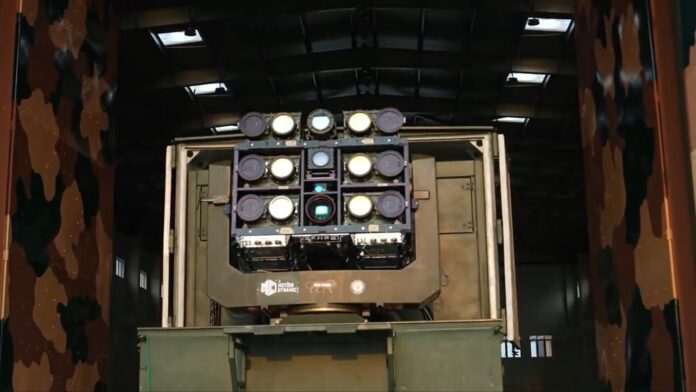India has taken a major step in emerging defence technology with the development and recent successful testing of its laser-based Directed Energy Weapon (DEW) system. With this development, India enters a small group of nations—including the United States, China, and Russia—that have operational or near-operational high-energy laser systems designed for combat roles.
This advancement has not only demonstrated the Defence Research and Development Organisation’s (DRDO) growing research and production capabilities but also showcased the viability of home-grown innovation in next-generation battlefield technologies.
https://twitter.com/DRDO_India/status/1911393160044904900
Successful Trials in Andhra Pradesh
In early April 2025, DRDO conducted trials of its Mk-II(A) laser DEW system at the National Open Air Range in Kurnool, Andhra Pradesh. The system reportedly tracked and engaged aerial targets, including fixed-wing drones, and disabled them using a concentrated 30-kilowatt laser beam. It was able to bring down multiple drones in succession, validating its targeting and endurance performance in an open-field setting.
Developed by DRDO’s Centre for High Energy Systems and Sciences (CHESS) with support from other labs and private Indian partners, this DEW system is portable and capable of deployment on ground-based mobile platforms. It is equipped with advanced optical and thermal imaging systems, providing precision even under adverse environmental conditions.
Operational Use Near the LoC
The DEW system was not just confined to test ranges. According to media reports, a prototype variant was used by the Indian Army to intercept and disable a Chinese-origin surveillance drone near the Line of Control. The drone was reportedly attempting to enter Indian airspace when it was neutralised without a single projectile being fired.
This real-time application offers a glimpse into how DEW technology may evolve into a dependable frontline deterrent—particularly in high-altitude and high-alert zones, where split-second decisions are often required.
What Makes This a Breakthrough?
Laser-based weapons, unlike kinetic interceptors or traditional firearms, offer instant line-of-sight engagement and do not require ammunition in the conventional sense. Once powered and calibrated, a DEW system can engage targets almost endlessly, restricted only by its energy reserves and system cooling.
Cost, Speed, and Strategic Impact
Cost efficiency in counter-drone operations is a key driver. The recent proliferation of low-cost drones for reconnaissance and cross-border strikes has challenged conventional defence systems. Intercepting a $500 drone with a $100,000 missile is not a sustainable model. Laser systems, with low per-use costs, fill this gap effectively.
Deployment flexibility is another advantage. The current prototype is mounted on a mobile platform and operates from ground installations. However, the modular nature of the design allows for future deployment on airborne and naval systems. DRDO has already indicated plans to scale the system to 100-kilowatt and eventually 300-kilowatt variants.
Stealth and precision enhance its utility. Unlike missile interceptors, DEW systems function without noise, vibration, or residue. This makes them ideal for sensitive areas like urban installations, power plants, border outposts, and airports, where a traditional interception might cause unintended collateral damage.
Global Context and India’s Distinct Path
India’s entry into the laser weapons domain mirrors similar developments in other countries. The United States has developed the HELIOS and LaWS systems, which have been deployed on naval destroyers for ship defence and drone interception. China has made investments in truck-mounted laser weapons to disable drones and satellites. Russia has announced its own Peresvet laser systems, though their deployment details remain unclear.
Unlike these powers, India’s approach has prioritised modularity and domestic production. The Mk-II(A) DEW is not imported or adapted—it is fully indigenised, a strategic move that reduces dependency on foreign platforms and opens potential export pathways in the future.
Technical Features of the Mk-II(A) System
The current 30-kW laser system uses solid-state laser technology and operates in the infrared spectrum. Its accuracy is achieved using a combination of electro-optical tracking, AI-based auto-target locking, thermal imaging sensors, and vibration dampening to maintain beam focus.
The entire unit is housed in a mobile station and comes with power management systems that allow for fast charging and emergency deployment. According to DRDO officials, the system’s effectiveness against swarms and fast-moving aerial objects was a priority design goal.
Challenges Ahead
Power and cooling remain a concern. High-energy lasers generate considerable heat. For prolonged operations, advanced cooling systems and uninterrupted power management will be vital—especially in tropical and desert terrains.
Weather limitations still exist. Laser beams can be affected by dust, fog, rain, or snow. While advanced optics and beam correction help, certain atmospheric conditions still challenge laser accuracy.
Policy and protocol considerations are equally relevant. As with all new technologies, rules for usage, integration with other systems, and interoperability with command structures need refinement. Protocols for cross-border engagements using silent, precise systems will also raise new policy debates.
Shifting Strategic Posture
The introduction of DEWs also indicates a shift in India’s posture. It suggests a move from reactive defence to active area-denial capabilities, especially against non-state actors and grey-zone incursions.
At the strategic level, DEWs provide an additional option to policymakers—something between verbal warnings and full-scale kinetic retaliation. They are hard to attribute, easy to deploy in non-lethal modes, and scalable according to the target type and intent.
India’s Ministry of Defence has quietly supported these developments with increased funding for futuristic weapons. The emphasis on Atmanirbhar Bharat aligns well with DRDO’s direction, and the absence of foreign suppliers in this project highlights the value of domestic research ecosystems.
A New Chapter in Precision Defence
The successful development and testing of the 30-kilowatt laser weapon system marks a new phase in India’s defence modernisation journey. With proven capability to track and disable aerial threats, this technology enhances India’s ability to respond to evolving security dynamics—not just with strength, but with sophistication.
As the system matures and future variants are introduced, India may well emerge as a contributor to global DEW norms, not merely as a user but as a designer of future deterrents. In a world of hypersonic missiles, drone swarms, and low-cost surveillance systems, such tools could redefine the boundaries of modern warfare.



